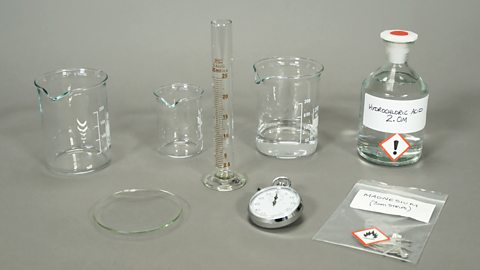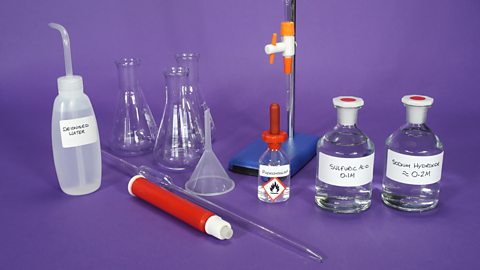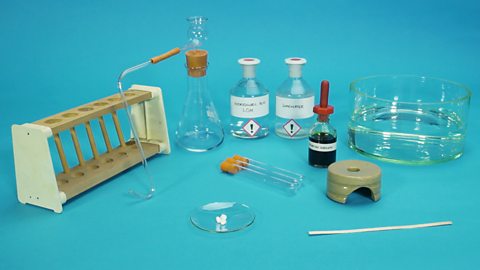What are the key learning points about practical C6?
The rate of reaction can be measured by investigating the time taken for reactantThe chemical present at the start of a reaction. Reactants appear on the left of a chemical equation, before the arrow →. to be used up or for productA chemical which is made in a chemical reaction. Products are written on the right of a chemical equation, after the arrow (→). to form.
For the reaction of magnesium with hydrochloric acid, the rate of reaction can be determined by measuring the time taken for a piece of magnesium to completely disappear.
The effect of concentration of the hydrochloric acid on the rate of reaction can be investigated by diluting the hydrochloric acid by different amounts.
What is the purpose of prescribed practical C6?
The rate of a chemical reaction can be thought of as:
How quickly reactants are used up, or how quickly products form.
There are a number of ways that a rates of reaction experiment can be carried out; in this experiment we will be looking at how quickly magnesium reacts with dilute hydrochloric acid.
If a piece of magnesium is dropped into some hydrochloric acid, it will react and eventually disappear.
The time it takes for the magnesium to be completely used up indicates the rate of the reaction.
You will investigate how the concentration of the hydrochloric acid will affect the rate of its reaction with magnesium.
You can vary the concentration of hydrochloric acid by diluting it with measured amounts of water.
What happens when investigating the rate of reaction?
Investigate how changing a variable changes the rate of reaction.
What apparatus is required for investigating the rate of reaction?

200 cm3 of 2 mol/dm3 hydrochloric acid and deionised water.
10 x 3 cm strips of magnesium.
100 cm3 beaker, 250 cm3 beaker, watch glass, measuring cylinder (25 cm3).
Stopwatch.
What are the steps involved in investigating the rate of reaction?
Carefully collect 200 cm3 of hydrochloric acid using the 250cm3 beaker, and 10 strips of magnesium using a watch glass.
Using the measuring cylinder, measure out 25 cm3 of hydrochloric acid and add to the small beaker. Remember to use the measuring cylinder accurately.
Drop the piece of magnesium ribbon into the beaker and start the stopwatch, swirl once to ensure the magnesium is fully coated in the acid. Stop the watch when all the magnesium disappears.
Repeat the experiment to ensure reliability of results.
Repeat steps 2-4 using a total of five different volumes of acid and water to ensure different concentrations of acid. The proportions you need to use are given in the results table:
Results table
| Experiment 1 | Experiment 2 | Average | ||
|---|---|---|---|---|
| Volume of hydrochloric acid / cm3 | Volume of deionised water / cm3 | Time taken for magnesium to disappear / s | Time taken for magnesium to disappear / s | Time taken for magnesium to disappear / s |
| 25 | 0 | |||
| 20 | 5 | |||
| 15 | 10 | |||
| 10 | 15 | |||
| 5 | 20 |
Safety
Follow the safety advice given by your teacher.
How to analyse the results of investigating the rate of reaction
In this experiment we can use the times to calculate an approximate value for the rate of each reaction by using the formula:-
\(Rate~= \frac {1}{time}\)
Using your average times calculate the rate of reaction for each experiment:-
| Average time / s | Rate / s-1 |
|---|---|
We can also calculate the percentage of acid used, or, since we know the original concentration of the acid is 2 mol/dm3, we can calculate the concentrate for each experiment:-
| Volume of acid / cm3 | Percentage acid | Concentration /mol/ dm3 |
|---|---|---|
| 25 | 100 | 2.0 |
| 20 | 80 | 1.6 |
| 15 | 60 | 1.2 |
| 10 | 40 | 0.8 |
| 5 | 20 | 0.4 |
Finally, we can plot a graph of our dependent variable (y-axis) against our independent variable (x-axis).
The independent variable will be either % acid, or concentration of hydrochloric acid.
The dependent variable will either be time or rate.
How much do you know about investigating the rate of reaction?
More on Unit 3: Prescribed practicals
Find out more by working through a topic
- count8 of 9

- count9 of 9
